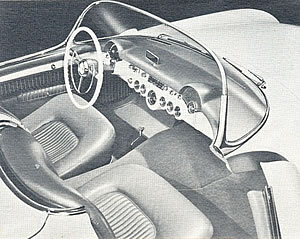Here’s a little-known fact for most people — you probably have it tattooed on your brain if you’re a real Corvette enthusiast — when the first 300 ‘Vettes rolled off the line in 1953 they were driven by almost exclusively by General Motors execs.
Dealers had to take orders and tell customers they’d have to wait for a couple of months while the automaker ramped up to make the country’s first fiberglass-body coupe, the Corvette C1.
Many-handmade parts

The early ‘Vettes were really exercises in futility, too. Taking the major parts from an Ohio-based supplier, each ‘Vette was handcrafted so that all of the panels lined up correctly as no one knew how to work with fiberglass and there were more than 46 major pieces that had to be fit together. This result was an initial production line where 46 individual car pieces were put together on clamped to individual jigs and where each vehicle slowly made its way into existence. It was done this way to ensure that each vehicle was perfect.
When they were finished with each vehicle, the design team had a vehicle with a the traditional long body/short deck two-place European-inspired sports car design. The front pieces, which featured a short sweep up into a cleanly lined hood and fenders that were nicely proportioned, established a beltline about half-way up the body. That line was carried through the doors and into the rear quarters were a short straight deck finished in two integrated taillights.
Harley Earle, chief designer of the automaker, wanted to make sure that headlights remained in one piece and so a piece of screening appeared in front of each headlight as each one was separated by some vertical bright work.
2 engine choices
Under the hood, the buyer could opt for a choice of two two-speed automatics and a 250-cubic-inch class inline six or a small, 289-cubic-inch V-8. That was all that was offered.
Nothing luxurious appeared including the cloth tops that were raised and lowered by hand and the side curtains that had to snap in — ale many of the two-place European cars of the day.
Performance wasn’t thrilling, but adequate with an 11-second 0 to 60 and a top end of about 105 mph. Still, it wasn’t bad and the handling was improved when they put four–ply tires on the vehicle, up from the two.
Market waiting to explode
The ‘Vette was a market waiting to explode. General Motors saw the potential as many GIs not only brought back their war brides from Europe after World War II but also brought back this taste for fast, two-place sports cars like the MG-TA, TB or TC or the Jaguar XJ-120, each of which followed the same lines at the ‘Vette.
About the only problem anyone had getting their hands on the ‘Vette was getting their hands on the 1954n’Vette. Now, one doesn’t know if this is apocryphal or not, but of the first 300 made, most of them ended up being driven by GM executives add dealers waited for the 1954 models as the excitement built.
